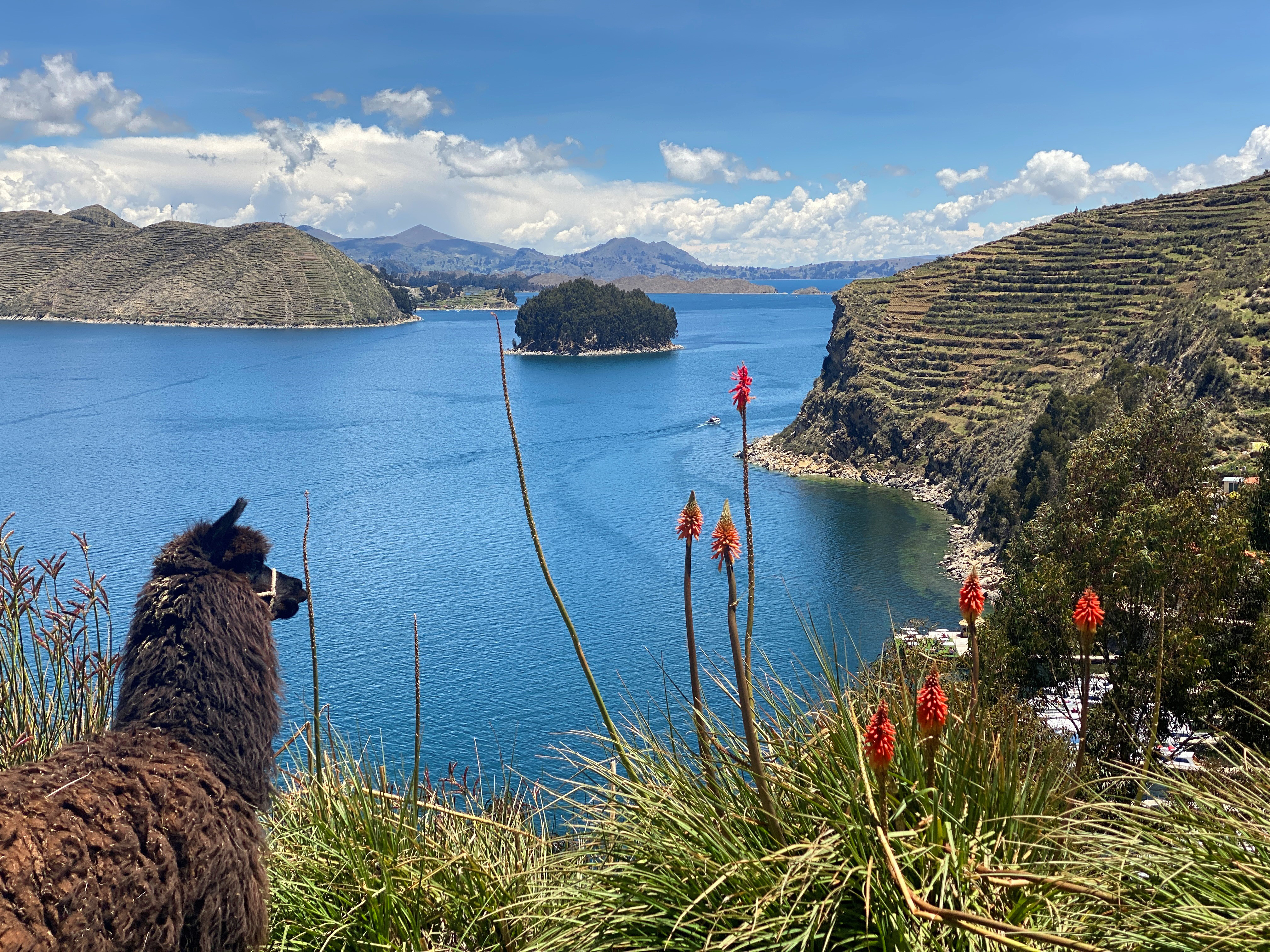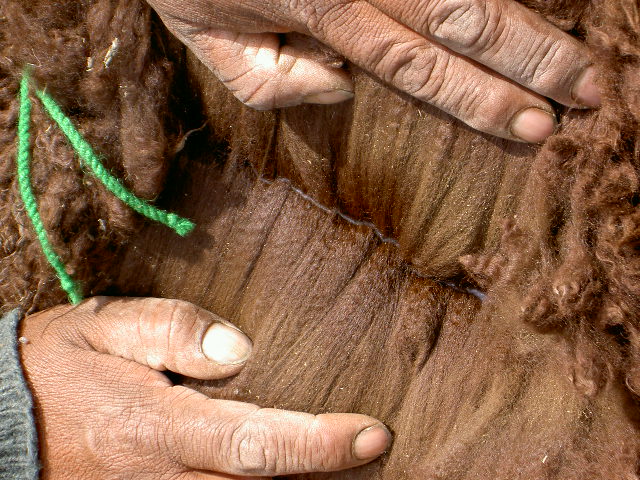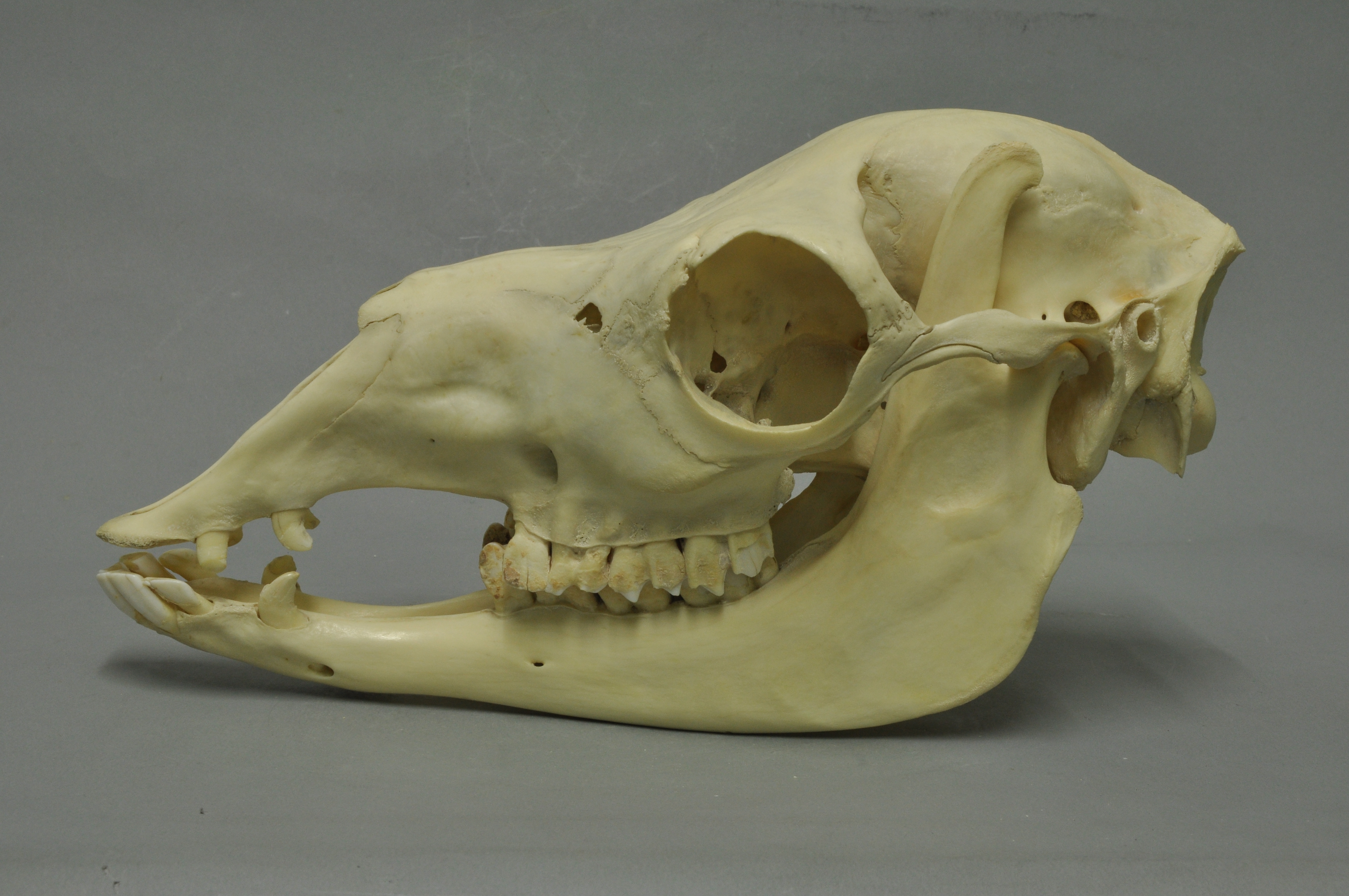|
Alpaca
The alpaca (''Lama pacos'') is a species of South American camelid mammal. Traditionally, alpacas were kept in herds that grazed on the level heights of the Andes of Southern Peru, Western Bolivia, Ecuador, and Northern Chile. More recently, alpacas may be found on farms and ranches worldwide, with thousands of animals born and raised annually. Alpacas are especially popular in North America, Europe, and Australia. There are two modern breeds of alpaca, separated based on their respective region of endemism and fiber (wool) type: the Suri alpaca and the Huacaya alpaca. Both breeds produce a highly valued fiber, with Suri alpaca's fiber growing in straight "locks," while Huacaya fiber has a "crimped," wavy texture and grows in bundles. These breeds' fibers are used for making knitted and woven items, similar to sheep's wool. Alpacas are visually and genetically similar to, and often confused with a relative species, the llamas; however, alpacas are visibly shorter and pr ... [...More Info...] [...Related Items...] OR: [Wikipedia] [Google] [Baidu] [Amazon] |
Alpaca Fiber
Alpaca fleece is the natural fiber harvested from an alpaca. There are two different types of alpaca fleece. The most common fleece type comes from a Huacaya. Huacaya fiber grows and looks similar to sheep wool in that the animal looks "fluffy". The second type of alpaca is Suri and makes up less than 10% of the South American alpaca population. Suri fiber is more similar to natural silk and hangs off the body in locks that have a dreadlock appearance. While both fibers can be used in the worsted milling process using light weight yarn or thread, Huacaya fiber can also be used in a woolen process and spun into various weight yarns. It is a soft, durable, luxuriousQuiggle, Charlotte. "Alpaca: An Ancient Luxury." ''Interweave Knits'' Fall 2000: 74-76. and silky natural fiber. While huacaya fiber is similar to sheep's wool, it is warmer, not prickly, and has no lanolin, which makes it hypoallergenic.Stoller, Debbie, ''Stitch 'N Bitch Crochet'', New York: Workman, 2006, p. 18. ... [...More Info...] [...Related Items...] OR: [Wikipedia] [Google] [Baidu] [Amazon] |
Huacaya Alpaca
The Huacaya alpaca is a breed of alpaca (''Lama pacos'') that has a unique appearance and fiber quality. This breed is the most popular alpaca breed with population numbers reaching 2.8 million in Peru alone. They share biological components with other species in the Camelidae family. Their digestive tract, nutrition requirements, and herd behavior mirror that of all camelids. They also survive amidst similar predation, poison, and disease threats that endanger all camelids alike. Breed The Huacaya alpaca is one of two breeds of alpaca, the other breed being the Suri alpaca. Both breeds were first domesticated by the Incas thousands of years ago from a wild species of camelid, the vicuña. The native homeland of the Huacaya is the Andean highlands of South America, called the Altiplano. It is above sea level and reaches into Peru, Chile, and Bolivia. * An edited version also published as: In the 1980s, these Huacaya were imported to other countries including Australia, Canad ... [...More Info...] [...Related Items...] OR: [Wikipedia] [Google] [Baidu] [Amazon] |
Llama
The llama (; or ) (''Lama glama'') is a domesticated South American camelid, widely used as a List of meat animals, meat and pack animal by Inca empire, Andean cultures since the pre-Columbian era. Llamas are social animals and live with others as a herd. Their wool is soft and contains only a small amount of lanolin. Llamas can learn simple tasks after a few repetitions. When using a pack, they can carry about 25 to 30% of their body weight for 8 to 13 kilometre, km (5–8 miles). The name ''llama'' (also historically spelled "lama" or "glama") was adopted by European colonization of the Americas, European settlers from Indigenous people in Peru, native Peruvians. The ancestors of llamas are thought to have originated on the Great Plains of North America about 40 million years ago and subsequently migrated to South America about three million years ago during the Great American Interchange. By the end of the last Quaternary glaciation, ice age (10,000–12,000 years ago) ... [...More Info...] [...Related Items...] OR: [Wikipedia] [Google] [Baidu] [Amazon] |
Lamoid
Lamini (members are called ''lamines'') is a tribe of the subfamily Camelinae. It contains one extant genus with four species, all exclusively from South America: llamas, alpacas, vicuñas, and guanacos. The former two are domesticated species, while the latter two are only found in the wild. None display sexual dimorphism. The four species can interbreed and produce fertile offspring. Additionally, there are several extinct genera. The digestive system of lamoids allows them to digest certain toxins. Laminoids also lack a gallbladder. Evolutionary history Lamines originated during the Miocene in North America, and migrated into South America during the Pliocene and Pleistocene as part of the Great American Interchange. Most species of lamines, including the genera '' Hemiauchenia'' and '' Palaeolama'' and all North American species, became extinct at the end of the Pleistocene around 12,000 years ago as part of the Quaternary extinction event along with most other large mam ... [...More Info...] [...Related Items...] OR: [Wikipedia] [Google] [Baidu] [Amazon] |
Vicugna Vicugna
''Lama'' is a genus containing the South American camelids: the wild guanaco and vicuña and the domesticated llama, alpaca, and the extinct chilihueque. Before the Spanish conquest of the Americas, llamas, alpacas, and chilihueques were the only domesticated ungulates of the continent. They were kept not only for their value as beasts of burden, but also for their flesh, hides, and wool. Classification Although they were often compared to sheep by early writers, their affinity to the camel was soon perceived. They were included in the genus ''Camelus'' in the ''Systema Naturae'' of Linnaeus. In 1800, Cuvier moved the llama, alpaca, and guanaco to the genus ''Lama'', and the vicuña to the genus ''Vicugna''. After genetic testing revealed that the alpaca descends from the vicuña it was also moved to genus ''Vicugna.'' The American Society of Mammalogists later moved the species of genus ''Vicugna'' back into genus ''Lama'' due to low genetic distance between the two. The R ... [...More Info...] [...Related Items...] OR: [Wikipedia] [Google] [Baidu] [Amazon] |
Vicuña
The vicuña (''Lama vicugna'') or vicuna (both , very rarely spelled ''vicugna'', Vicugna, its former genus name) is one of the two wild South American camelids, which live in the high alpine tundra, alpine areas of the Andes; the other camelid is the guanaco, which lives at lower elevations. Vicuñas are relatives of the llama, and are now believed to be the wild ancestor of domesticated alpacas, which are raised for their coats. Vicuñas produce small amounts of extremely fine wool, which is very expensive because the animal can be shorn only every three years and has to be caught from the wild. When knitted together, the product of the vicuña's wool is very soft and warm. The Inca valued vicuñas highly for their wool, and it was against the law for anyone but royalty to wear vicuña garments; today, the vicuña is the national animal of Peru and appears on the Coat of arms of Peru, Peruvian coat of arms. Both under the rule of the Inca and today, vicuñas have been protect ... [...More Info...] [...Related Items...] OR: [Wikipedia] [Google] [Baidu] [Amazon] |
Crossbreed
A crossbreed is an organism with purebred parents of two different breeds, varieties, or populations. A domestic animal of unknown ancestry, where the breed status of only one parent or grandparent is known, may also be called a crossbreed though the term "mixed breed" is technically more accurate. Outcrossing is a type of crossbreeding used within a purebred breed to increase the genetic diversity within the breed, particularly when there is a need to avoid inbreeding. In animal breeding, ''crossbreeds'' are crosses within a single species, while ''Hybrid (biology), hybrids'' are crosses between different species. In plant breeding terminology, the term ''crossbreed'' is uncommon, and no universal term is used to distinguish hybridization or crossing within a population from those between populations, or even those between species. Crossbreeding is the process of breeding such an organism. It can be beneficially used to maintain health and viability of organisms. However, irresp ... [...More Info...] [...Related Items...] OR: [Wikipedia] [Google] [Baidu] [Amazon] |
Camelid
Camelids are members of the biological family (biology), family Camelidae, the only currently living family in the suborder Tylopoda. The seven extant taxon, extant members of this group are: dromedary, dromedary camels, Bactrian camels, wild Bactrian camels, llamas, alpacas, vicuñas, and guanacos. Camelids are even-toed ungulates classified in the order (biology), order Artiodactyla, along with species including whales, pigs, deer, cattle, and antelopes. Characteristics Camelids are large, strictly herbivorous animals with slender necks and long legs. They differ from ruminants in a number of ways.Fowler, M.E. (2010). ''Medicine and Surgery of Camelids'', Ames, Iowa: Wiley-Blackwell. Chapter 1 "General Biology and Evolution" addresses the fact that camelids (including camels and llamas) are not ruminants, pseudo-ruminants, or modified ruminants. Their dentition show traces of vestigial central incisors in the incisive bone, and the third incisors have developed into canine-li ... [...More Info...] [...Related Items...] OR: [Wikipedia] [Google] [Baidu] [Amazon] |
Andes
The Andes ( ), Andes Mountains or Andean Mountain Range (; ) are the List of longest mountain chains on Earth, longest continental mountain range in the world, forming a continuous highland along the western edge of South America. The range is long and wide (widest between 18th parallel south, 18°S and 20th parallel south, 20°S latitude) and has an average height of about . The Andes extend from south to north through seven South American countries: Argentina, Chile, Bolivia, Peru, Ecuador, Colombia, and Venezuela. Along their length, the Andes are split into several ranges, separated by intermediate depression (geology), depressions. The Andes are the location of several high plateaus—some of which host major cities such as Quito, Bogotá, Cali, Arequipa, Medellín, Bucaramanga, Sucre, Mérida, Mérida, Mérida, El Alto, and La Paz. The Altiplano, Altiplano Plateau is the world's second highest after the Tibetan Plateau. These ranges are in turn grouped into three majo ... [...More Info...] [...Related Items...] OR: [Wikipedia] [Google] [Baidu] [Amazon] |
Camelid
Camelids are members of the biological family (biology), family Camelidae, the only currently living family in the suborder Tylopoda. The seven extant taxon, extant members of this group are: dromedary, dromedary camels, Bactrian camels, wild Bactrian camels, llamas, alpacas, vicuñas, and guanacos. Camelids are even-toed ungulates classified in the order (biology), order Artiodactyla, along with species including whales, pigs, deer, cattle, and antelopes. Characteristics Camelids are large, strictly herbivorous animals with slender necks and long legs. They differ from ruminants in a number of ways.Fowler, M.E. (2010). ''Medicine and Surgery of Camelids'', Ames, Iowa: Wiley-Blackwell. Chapter 1 "General Biology and Evolution" addresses the fact that camelids (including camels and llamas) are not ruminants, pseudo-ruminants, or modified ruminants. Their dentition show traces of vestigial central incisors in the incisive bone, and the third incisors have developed into canine-li ... [...More Info...] [...Related Items...] OR: [Wikipedia] [Google] [Baidu] [Amazon] |
Guanaco
The guanaco ( ; ''Lama guanicoe'') is a camelid native to South America, closely related to the llama. Guanacos are one of two wild South American camelids; the other species is the vicuña, which lives at higher elevations. Etymology The guanaco gets its name from the Quechua word ''wanaku''. Young guanacos are called ''chulengos'' or "guanaquitos". Characteristics Guanacos stand between at the shoulder, body length of , and weigh . Their color varies very little (unlike the domestic llama), ranging from a light brown to dark cinnamon and shading to white underneath. Guanacos have grey faces and small, straight ears. The lifespan of a guanaco can be as long as 28 years. Guanacos are one of the largest terrestrial mammals native to South America today.San Diego Zoo's Animal Bytes Other terrestrial mammalian [...More Info...] [...Related Items...] OR: [Wikipedia] [Google] [Baidu] [Amazon] |
Suri Alpaca
Suri may refer to: Places * Suri, Birbhum, a town in West Bengal, India ** Suri I, community development block in West Bengal, India ** Suri II, community development block in West Bengal, India ** Suri Sadar subdivision, administrative subdivision in West Bengal, India ** Suri (Vidhan Sabha constituency), an assembly constituency in Birbhum district in the Indian state of West Bengal * Suri dynasty, a former South Asian empire * Şuri, a commune in Drochia District, Moldova * Suri, Hamadan, a village in Hamadan province, Iran * Suri, Khuzestan, a village in Khuzestan province, Iran * Suri District, an administrative division of Rumeshkan County, Lorestan province, Iran * Suri Rural District, an administrative division of Rumeshkan County, Lorestan province, Iran * Suri, Lorestan, a village in Lorestan province, Iran * Suri, West Azerbaijan, a village in West Azerbaijan province, Iran * Suri, Dolakha, Gaurishankar Rural Municipality, Dolakha District, Nepal * Sori, ... [...More Info...] [...Related Items...] OR: [Wikipedia] [Google] [Baidu] [Amazon] |








